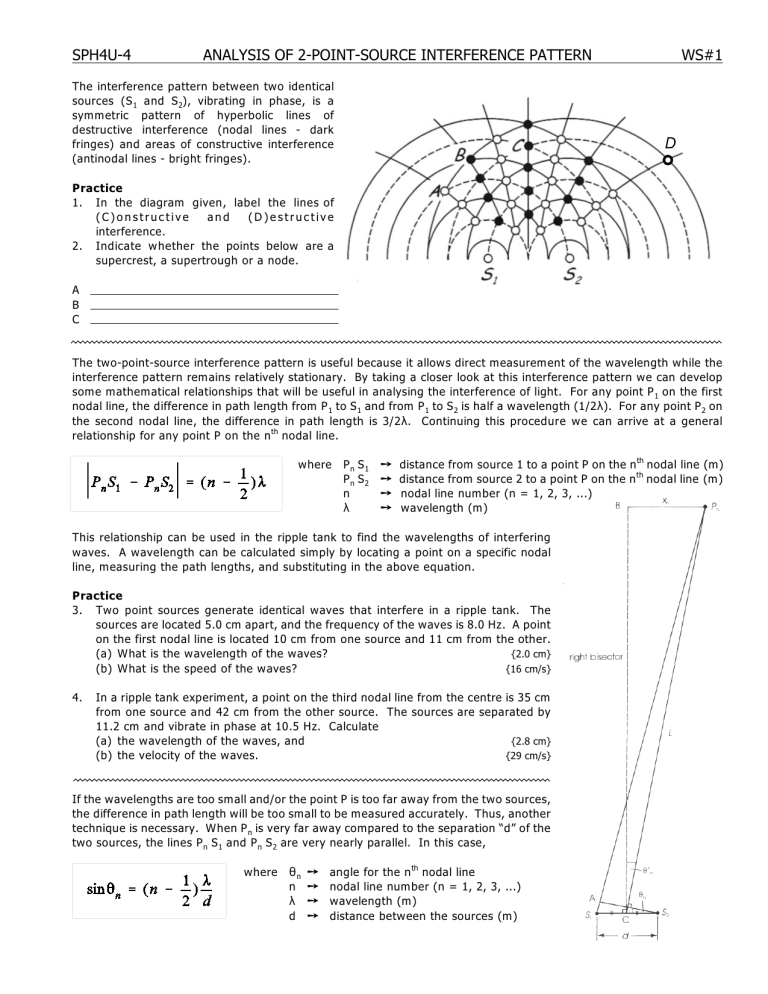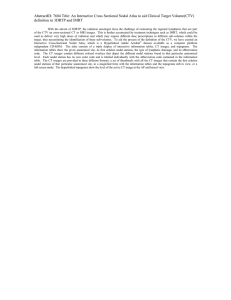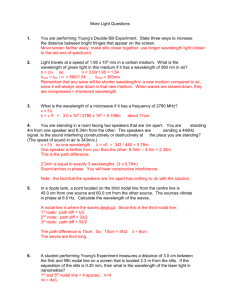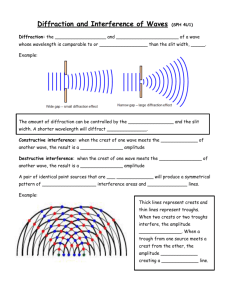2-Point-Interference
advertisement

SPH4U-4
ANALYSIS OF 2-POINT-SOURCE INTERFERENCE PATTERN
WS#1
The interference pattern between two identical
sources (S 1 and S 2), vibrating in phase, is a
symmetric pattern of hyperbolic lines of
destructive interference (nodal lines - dark
fringes) and areas of constructive interference
(antinodal lines - bright fringes).
Practice
1. In the diagram given, label the lines of
(C)onstructive
and
(D )estructive
interference.
2. Indicate whether the points below are a
supercrest, a supertrough or a node.
A
B
C
The two-point-source interference pattern is useful because it allows direct measurement of the wavelength while the
interference pattern remains relatively stationary. By taking a closer look at this interference pattern we can develop
some mathematical relationships that will be useful in analysing the interference of light. For any point P 1 on the first
nodal line, the difference in path length from P 1 to S 1 and from P 1 to S 2 is half a wavelength (1/2 8 ). For any point P 2 on
the second nodal line, the difference in path length is 3/2 8 . Continuing this procedure w e can arrive at a general
relationship for any point P on the n th nodal line.
where
Pn S1
Pn S2
n
8
û
û
û
û
distance from source 1 to a point P on the n th nodal line (m)
distance from source 2 to a point P on the n th nodal line (m)
nodal line number (n = 1, 2, 3, ...)
wavelength (m)
This relationship can be used in the ripple tank to find the wavelengths of interfering
waves. A wavelength can be calculated simply by locating a point on a specific nodal
line, measuring the path lengths, and substituting in the above equation.
Practice
3. Two point sources generate identical waves that interfere in a ripple tank. The
sources are located 5.0 cm apart, and the frequency of the waves is 8.0 Hz. A point
on the first nodal line is located 10 cm from one source and 11 cm from the other.
(a) What is the wavelength of the waves?
{2.0 cm}
(b) What is the speed of the waves?
{16 cm/s}
4.
In a ripple tank experiment, a point on the third nodal line from the centre is 35 cm
from one source and 42 cm from the other source. The sources are separated by
11.2 cm and vibrate in phase at 10.5 Hz. Calculate
(a) the wavelength of the waves, and
{2.8 cm}
(b) the velocity of the waves.
{29 cm/s}
If the wavelengths are too small and/or the point P is too far away from the two sources,
the difference in path length will be too small to be measured accurately. Thus, another
technique is necessary. When P n is very far away compared to the separation “d” of the
two sources, the lines P n S 1 and P n S 2 are very nearly parallel. In this case,
where
2n û
n û
8 û
d û
angle for the n th nodal line
nodal line number (n = 1, 2, 3, ...)
wavelength (m)
distance between the sources (m)
Practice
5. In a ripple tank, the second nodal line makes an angle of 25° with the right bisector. If the distance between the
sources is 10.0 cm, what is the wavelength of the waves?
{2.8 cm}
6. The previous formula was for destructive interference (ie a nodal line or dark fringe). Explain how the formula would
change to allow us to analyze constructive interference?
{sin 2 n = n 8 / d where n = 0,1,2,...}
In the ripple tank it is relatively easy to measure the angle 2 n but this is not the case for light where both the wavelength
and the distance between the sources are very small and the nodal lines are close together. In this case,
where
d
û distance between sources (m)
x n û z distance from ü bisector to point P on n th nodal line (m)
L û distance from point P to midpoint between the two sources (m)
n û nodal line number (n = 1, 2, 3, ...)
Practice
7. A page in a student’s notebook lists the following information obtained from a ripple tank experiment with two point
sources operating in phase: n = 3, x 3 = 35 cm, L = 77 cm, d = 6.0 cm, 2 3 = 25°, and 5 crests = 4.2 cm.
(a) Determine the wavelength of the waves, using 3 different methods/formulas. (Hint: How many wavelengths
are represented by 5 crests?)
{1.1 cm, 1.0 cm, 1.1 cm}
(b) You should find that the three answers are slightly different. Give 2 reasons why.
8.
Refer to the diagram at the top of page 1 to answer the following question: using a ruler and protractor, take
appropriate m easurements of point D to determine the value of the wavelength of the interfering waves. Be sure
to use all three methods of wave analysis. (Scale: 1.0 mm = 1.0 cm)
{10.7 or 11 cm, 10.7 or 11 cm, 10.8 or 11 cm}
9.
Two sources 6.0 cm apart, operating in phase, produce water waves. A student selects a point on the first nodal
line and measures from it 30.0 cm to a point m idway between the sources and 5.0 cm (on the perpendicular) to the
right bisector.
(a) What is the wavelength of the waves?
{2.0 cm}
(b) When the student selects a point on the second nodal line, he finds that it is 38.0 cm from the m idpoint and 21.0
cm from the right bisector. Determine the wavelength.
{2.2 cm}
(c) What would be the value of the angle for the points on the 1 st and 2 nd nodal lines described above? {9.6°, 34°}
10. An interference pattern is set up by two coherent point sources. A point on the second nodal line is 25 cm from
one source and 29.5 cm from the other source. If the speed of the waves is 7.5 cm/s calculate
(a) the wavelength and
{3.0 cm}
(b) the frequency of the sources.
{2.5 Hz}
11. Two sources vibrating in phase set up waves in a ripple tank. A point P on the second nodal line is 12.0 cm from
source A and 20.0 cm from source B. When the sources are started, it takes 2.0 s for the first wave to reach the
edge of the tank, 30 cm from the source. Find the velocity, wavelength, and frequency of the wave.
{15 cm/s, 5.3 cm, 2.8 Hz}
12. Two very small, identical loudspeakers, each of which is
radiating sound uniformly in all directions, are placed at points
S 1 and S 2 as shown. They are connected to a source so that
they radiate, in phase, a sound with a wavelength of 2.00 m.
The speed of sound may be taken as 340 m/s.
(a) What is the frequency of the radiated sound?
{170 Hz}
(b) Point M, a nodal point, is 7.0 m from S 1 and more than
7.0 m from S 2. W hat are three possible distances that M
could be from S 2?
{8.0 m, 10 m, 12 m}
(c) Point N, also a nodal point, is located 12.0 m from S 1 and
5.0 m from S 2. On what nodal line is N located?
{4}
13. Com plete the following statements below by filling in the missing word(s).
(a) Decreasing the width of a slit
?
the amount of diffraction.
(b) Increasing the frequency (or lowering the
?
) of the sources
?
the num ber of nodal lines.
(c) Increasing the separation of the sources
?
the num ber of nodal lines.
(d) Changing the relative phase of the sources changes the
?
of the nodal lines but not the
?
.




